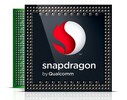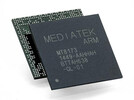Rockchip RK3288 vs Qualcomm Snapdragon 800 MSM8974 vs Mediatek MT8176
Rockchip RK3288
► remove from comparison
The Rockchip RK3288 is a mid-range ARM SoC for Android and Chrome OS mobile systems. It integrates four Cortex-A12 cores clocked at up to 1.8 GHz. ARM calls these cores Cortex-A17 due to them having very similar performance levels. The SoC includes an ARM Mali-T760 MP4 (also called Mali-T764) GPU clocked at 600 MHz and a dual-channel DDR3, DDR3L, LPDDR2, LPDDR3 memory controller.
The ARM Cortex-A12 is the successor to the Cortex-A9 and is based on a 32 Bit ARMv7-A microarchitecture. A single A12 core should be roughly 40 % more powerful than an A9 core according to ARM.
The integrated video engine supports encoding of H.264, VP8, and MVC videos up to 1080p. Decoding is supported for videos up to 4K H.264 and 10 Bit H.265.
The chip is manufactured under a 28 nm HKMG process.
Qualcomm Snapdragon 800 MSM8974
► remove from comparison
The Qualcomm Snapdragon 800 MSM8974 is an ARM-based SoC for tablets and smartphones. It is built at TSMC in a 28nm HPM (High Performance Mobile) HKMG process, whereas the Snapdragon 600 was manufactured in 28nm LP. In addition to 4 CPU cores with a clock speed of up to 2.3 GHz, the chip also integrates an Adreno 330 GPU up to 450 MHz, an LPDDR3-1600 memory controller and various radio modules (UMTS/LTE, WiFi, Bluetooth, GPS).
Processor
The CPU portion is based on Qualcomm's Krait architecture, which is compatible with ARMv7 ISA. Compared to the Snapdragon 600 (Krait 300), the new Krait 400 cores of the Snapdragon 800 have been tweaked just slightly with faster L2 cache. Thanks to a clock rate of up to 2.3 GHz and a high performance per MHz somewhere between an ARM Cortex-A9 and a Cortex-A15, the Snapdragon 800 offers very strong CPU performance. The S800 competes with the Nvidia Tegra 4, Samsung Exynos 5420 and Apple A7 and is therefore one of the fastest ARM SoCs on the market as of 2013.
Graphics
Another difference between the Snapdragon 600 and 800 is the graphics unit. While the S600 implements an Adreno 320 (400 to 450 MHz), the S800 features the faster Adreno 330 (450 MHz). Both GPUs offer the same amount of texture units (8 TMUs), but the Adreno 330 has 50 percent more shaders (probably 6x SIMD16 vs. 4x SIMD16 of the previous generation). In conjunction with the higher memory bandwidth, the performance is significantly better. As a result, the Adreno 330 is slightly faster than the Mali-T628 (Exynos 5420) and the PowerVR G6430 (Apple A7). Depending on the device and cooling, however, the performance may vary. The GPU supports OpenGL ES 3.0 as well as OpenCL 1.2.
Features
Furthermore, the MSM8974 supports many wireless technologies: Bluetooth 4.0, WLAN, IEEE 802.11a/b/g/n/ac (2.4/5 GHz), GSM (GPRS, EDGE), W-CDMA/UMTS (HSDPA, HSUPA, HSPA+, cat.29 DC-HSPA+), MBMS, cat.4 LTE, CDMA2000 (1X RTT, 1 × EV-DO Rel.0/Rev.A/Rev.B, 1× EV-DO Rev.A MC, 1× Adv Rev.A/Rev.B) and TD-SCDMA.
The MSM8974 can encode and play UHD 4K videos in 3840x2160 at 30 FPS (120 Mbps H.264 High Profile) sumiltaneously via dedicated hardware. Moreover, it supports both USB 2.0 and 3.0 and cameras up to 55 megapixels and stereoscopic 3D.
Power Consumption
Thanks to the new 28nm HPM HKMG process, the energy efficiency has been improved significantly compared to its LP 28nm S600 predecessor. Depending on the field of application, the maximum power consumption should be about 3 W for smartphones or 4 W or greater for tablets. This should be similar to comparable ARM SoCs currently in the market.
Mediatek MT8176
► remove from comparison
The Mediatek MT8176 is an upper mainstream ARM SoC (System on a chip) that was introduced in October 2016 and is primarily used for Android based tablets. It has two fast Cortex-A72 CPU cores running at up to 2.1 GHz and four Cortex-A53 cores for power-saving in a big.LITTLE configuration. The graphics unit is based on the IMG Series 6XT (Rogue) and has the designation PowerVR GX6250 clocked at 600 MHz. Among others, the GPU includes a video decoder with 4K and H.265 support (not verified, but was already the case for the older MT8173).
Processor
The biggest highlight of the SoC are the new Cortex-A72 cores, which can be seen as the successors to the Cortex-A57 design. ARM promises much more performance in combination with reduced power consumption, which results in an excellent per-thread performance with the very high maximum clock of 2.4 GHz. The architecture is based on ARMv8-ISA and therefore supports 64-bit.
The four slower, but therefore very frugal Cortex-A53 cores (clocks unknown, probably around 1.4 GHz) are supposed to reduce the power consumption and are always active with light workloads. The big.LITTLE configuration also allows the simultaneous use of all six cores (or any combination of cores from both clusters), so the MT8173 can be called a real hexa-core.
Graphics
The graphics unit is based on Series 6XT (Rogue) from IMG and has the designation PowerVR GX6250. The 2-cluster chip has a unified-shader architecture with a total of 64 FP32 ALUs as well as 4 TMUs. Compared to the MT8173, the clocks were reduced from 700 to 600 MHz, so the gaming performance is a bit lower. High-resolution screens and complex Android games should be powered without bigger problems.
| Model | Rockchip RK3288 | Qualcomm Snapdragon 800 MSM8974 | Mediatek MT8176 | ||||||||||||||||||||||||||||||||||||||||||||||||||||||||||||||||||||||||||||||||||||||||||||||||||||||||||||
| Series | Qualcomm Snapdragon | Mediatek | |||||||||||||||||||||||||||||||||||||||||||||||||||||||||||||||||||||||||||||||||||||||||||||||||||||||||||||
| Series: Mediatek Cortex-A72/-A53 |
|
|
| ||||||||||||||||||||||||||||||||||||||||||||||||||||||||||||||||||||||||||||||||||||||||||||||||||||||||||||
| Clock | 1800 MHz | 2300 MHz | 2100 MHz | ||||||||||||||||||||||||||||||||||||||||||||||||||||||||||||||||||||||||||||||||||||||||||||||||||||||||||||
| Cores / Threads | 4 / 4 | 4 / 4 | 6 / 6 | ||||||||||||||||||||||||||||||||||||||||||||||||||||||||||||||||||||||||||||||||||||||||||||||||||||||||||||
| Technology | 28 nm | 28 nm | 28 nm | ||||||||||||||||||||||||||||||||||||||||||||||||||||||||||||||||||||||||||||||||||||||||||||||||||||||||||||
| Features | ARM MAli-T624 at 600 MHz, dedicated 2D processor, 1080P H.264, VP8, MVC encoding, 4K H.264 and 10 Bits H.265 decoding, 1080p multi video decode, Dual-channel DDR3(L) memory controller, HDMI 2.0 | Adreno 330 (450 MHz), LTE cat.4, UMTS, MBMS, GSM, CDMA2000, tD-SCDMA, 802.11a/b/g/n/ac (2.4/5 GHz), Bluetooth 4.0, 2x 32 Bit LPDDR3-1600 Memory Controller (12.8 GB/s) | 20 MP Camera ISP, 4K Video Encoder, H.265, PowerVR GX6250 GPU | ||||||||||||||||||||||||||||||||||||||||||||||||||||||||||||||||||||||||||||||||||||||||||||||||||||||||||||
| iGPU | ARM Mali-T760 MP4 (600 MHz) | Qualcomm Adreno 330 (450 MHz) | PowerVR GX6250 (600 MHz) | ||||||||||||||||||||||||||||||||||||||||||||||||||||||||||||||||||||||||||||||||||||||||||||||||||||||||||||
| Architecture | ARM | ARM | ARM | ||||||||||||||||||||||||||||||||||||||||||||||||||||||||||||||||||||||||||||||||||||||||||||||||||||||||||||
| Announced | |||||||||||||||||||||||||||||||||||||||||||||||||||||||||||||||||||||||||||||||||||||||||||||||||||||||||||||||
| Manufacturer | www.rk3288.com | www.mediatek.com | |||||||||||||||||||||||||||||||||||||||||||||||||||||||||||||||||||||||||||||||||||||||||||||||||||||||||||||
| Codename | Krait 400 | Cortex-A72/-A53 | |||||||||||||||||||||||||||||||||||||||||||||||||||||||||||||||||||||||||||||||||||||||||||||||||||||||||||||
| L1 Cache | 0 MB | ||||||||||||||||||||||||||||||||||||||||||||||||||||||||||||||||||||||||||||||||||||||||||||||||||||||||||||||
| L2 Cache | 2 MB | ||||||||||||||||||||||||||||||||||||||||||||||||||||||||||||||||||||||||||||||||||||||||||||||||||||||||||||||


 Deutsch
Deutsch English
English Español
Español Français
Français Italiano
Italiano Nederlands
Nederlands Polski
Polski Português
Português Русский
Русский Türkçe
Türkçe Svenska
Svenska Chinese
Chinese Magyar
Magyar
